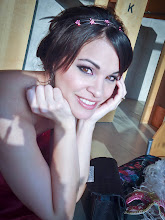Coasters make the perfect medium for a mini album. They are made out of chipboard, which makes them sturdier than regular cardstock. Plus, once you cover them with paper, no on will be none the wiser.
Here is a mini album I made with 5 coasters. It has pictures of everyone and what the individual likes at this very moment. Since there isn't a lot of product on the pages, it was quick and easy.




 The Summers Family
The Summers Family
MATERIALS
Patterned Papers:
-Heidi Swapp Carefree
-Heidi Swapp Runway
Felt Arrow, Stars, and Heart: Fancy Pants
Paper Piercer: Heidi Swapp Petite Piercer
Craft Knife: Heidi Swapp Paper Knife
Black Pen: American Crafts Memory Markers
Ink: ColorBox
Hole Puncher: Crop-A-Dile
Adhesive: EZ Runner
Chipboard Hearts: Making Memories
Chipboard Letters: Heidi Swapp
Mask: Heidi Swapp
Flowers: Petaloo
Paper Edging: Doodlebug Paper Frills
Dymo Labeler
HOW TO
First you will need to choose paper for each of the coasters. Cut 10 pieces, each 4"x4". Use your tape runner and run a strip of adhesive as close to the edge of your square as possible. Firmly press the paper to your chipboard.
To make stitches on the front cover, use the Heidi Swapp paper piercer and punch holes, spreading them out 1/4". Then use embroidery floss and tie a neat knot where you begin and end. Draw a freehand heart, cut out from the patterend paper, then cut a smaller heart out of the middle. Use a letter sticker the corresponds with your last name. All of the edges are distressed using ColorBox ink pads. To do this, lightly run your ink pad across the edges at a slight angle. I also like to outline my letters/embellishments when they are on a busy patterned paper. It makes it stand out a bit more.
The second page utilizes a technique called masking. Masking is taking an item (here I used a Heidi Swapp bird mask) and painting or inking over it. The surrounding paper will change color, while the paper under the mask will remain the same. I used different ink pads to achieve this look. The journaling refers to the things my family enjoys doing together.
The third page laters a photo over the top of two hand drawn flowers that have been outlined to stand out against the background. Ink the edges. Behind this page is journaling referring to what the person in the photo enjoys.
The following pages utilizes the same techniques. The edges have been inked, the photos are outlined to help them pop off the page, and a felt shape has been added.
To bind the album together, I used a Crop-A-Dile to first punch a hole in the middle of each page (approximately 1/2 inch away from the edge). Then running a thick ribbon through the holes, I tied it together. Use various sized ribbons in various colors, tied to the larger ribbon, for extra color and texture.
If you have any questions, please feel free to ask!


